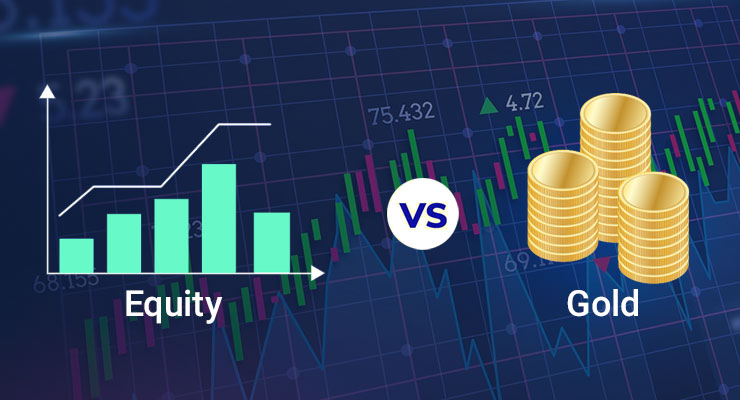Introduction
Nifty 50 vs Gold: Which is the Best Investment option? Are you puzzled about where to invest your hard-earned money? Let’s dive deep and explore the facts to make your decision a bit easier. To start with, one must understand the concept of Nifty 50. It represents the top 50 companies listed on the National Stock Exchange (NSE) of India, and it showcases the overall market performance of these companies. On the other hand, Gold is a precious metal that has been in demand for centuries for personal adornment and as a medium of investment.
When it comes to historical returns, both Nifty 50 and Gold have shown promising returns over time. However, being a stock market index, investing in Nifty 50 comes with a higher risk factor than gold. Gold, being a physical asset, is a bit more stable in its returns. So what to choose, Nifty 50 or Gold? The answer is simple – diversification. It is always advisable to diversify your investments and not put all eggs in one basket. A diversified portfolio can help in balancing the risk and returns.
In conclusion, while both Nifty 50 and Gold have their benefits and drawbacks, a balanced approach with a diversified portfolio is the best option. Keep a long-term investment horizon and stay updated with the market fluctuations to make informed investment decisions.
Understanding Nifty 50

If you’re new to the investing world, the term Nifty 50 might sound alien to you. Well, let me break it down for you. Nifty 50 is an index of the National Stock Exchange of India (NSE), comprising 50 actively traded stocks. These stocks represent various sectors of the Indian economy, including banking, IT, energy, and FMCG.
But how does it work? In simple words, the value of Nifty 50 is calculated using the free-float methodology. This means that the market capitalization of each company is multiplied by its free-floating shares’ total number. As a result of this calculation, Nifty 50 provides investors with a broader picture of the Indian stock market’s performance. Many factors affect the Nifty 50, and one such factor is market sentiment.
When investors are optimistic about the future, the market tends to trend upwards, and vice versa. Additionally, global economic trends and government policies also play a crucial role in influencing the Nifty 50’s performance. So, basically, investing in Nifty 50 means investing in the Indian economy. But is it the best investment option out there? Let’s find out in the upcoming sections.
Understanding Gold
Gold has been a popular investment option for centuries and for good reason. It is not just a shiny metal that people wear as jewelry, but it can also act as an investment tool. Investing in gold means buying gold in different forms such as jewelry, gold coins or bars, or even in electronic form through Gold ETFs.
The value of gold is determined through demand and supply forces, geopolitical tensions, inflation, and interest rates. One of the biggest advantages of gold as an investment option is that it has historically been a safe haven during turbulent times. Gold has acted as a store of value during times of economic instability, inflation, and even war. This is because of its limited supply and universal appeal. Investing in gold can be done through various channels.
One can invest in physical gold, Gold ETFs or Gold mutual funds. Physical gold has advantages such as ease of liquidity and high liquidity in comparison to Gold ETFs and mutual funds. Gold ETFs and Gold mutual funds carry additional advantages such as convenience, cost-effectiveness, and flexibility. The value of gold is subject to change based on various factors such as political instability, market forces, inflation, or even natural calamities.
One must keep a close watch on these factors while making investments in gold. In conclusion, gold can be considered a safe and stable investment option that can act as a store of value during turbulent times. It offers different channels of investment such as physical gold, Gold ETFs or mutual funds and the value of it is determined by demand and supply factors, geopolitical tensions, inflation and interest rates. So, investing in gold can help to diversify and balance one’s portfolio.

Historical Returns
Historical Returns: Investing is all about making smart choices that are backed by data, which makes historical performance an important aspect to consider before investing. When it comes to Nifty 50 and gold, both have shown promising returns in the past.
Over the past decade, Nifty 50 has given an average annual return of around 12%. However, it is important to note that the performance can vary in different market scenarios. For instance, Nifty 50 had a major correction during the COVID-19 pandemic, but it bounced back quickly as well. On the other hand, gold has been a traditionally safe investment option during uncertainties and economic downturns.
Over the past decade, gold has given an average return of around 10%. The value of gold tends to rise during times of inflation and is therefore considered a good hedge against inflation. It is essential to keep in mind that past performance does not guarantee future returns. Investing decisions should be made based on a holistic understanding of the market, trends, and risk appetite. Diversification: Although Nifty 50 and gold have their own benefits, diversifying investments across different asset classes is recommended.
Diversification helps in reducing risk by spreading investments across various assets. One can create a diverse investment portfolio by combining Nifty 50 with gold and other investments like mutual funds, fixed deposits, and real estate. This strategy helps in balancing returns and reducing overall portfolio risk. In conclusion, Nifty 50 and gold have their own advantages and disadvantages.
Investing choices should be made based on personal investment goals, risk appetite, and market trends. One should consider diversifying their investments across different asset classes to mitigate overall portfolio risk.
Risk vs Return

Risk vs Return: Investment in Nifty 50 comes with a certain degree of risk. Since it is an equity index, any negative event can have an impact on the stock prices of the companies in the Nifty 50. The performance of Nifty 50 depends on various factors such as economic indicators, company performance, and even political policies. Therefore, investing in Nifty 50 should be done after careful analysis and understanding of the market trends. On the other hand, gold investment is considered a safe haven for investors.
Gold prices are known to rise during times of economic and political instability. However, gold prices are also dependent on factors such as central bank policies, inflation, and currency rates. Additionally, since gold does not provide any income, the return on investment is purely based on the appreciation of gold prices. When comparing the returns of Nifty 50 and Gold, the historical data shows that both investments have had their share of ups and downs.
In the last five years, Nifty 50 has given a return of around 12% p.a, while gold has given a return of around 6-7% p.a. However, past performance doesn’t guarantee future returns. It’s important to understand that with higher returns come higher risks. Nifty 50 investments may give higher returns, but the risk associated with it is also higher. Whereas, gold investment is considered to have lower risks but lower returns. Therefore, the decision to invest in either Nifty 50 or Gold depends on the investor’s risk appetite.
If the investor is looking for higher returns and is willing to take higher risks, Nifty 50 can be a good investment option. On the other hand, if the investor’s priority is capital preservation and lower risk, then gold is the safer investment choice. Diversification is the key to a balanced portfolio. Investors should consider diversifying their investments, including both Nifty 50 and gold in their portfolio. This will help minimise risk and stabilise returns.
Diversification
Importance of portfolio diversification cannot be emphasized enough. Whichever investment one chooses, there are inherent risks associated. While Nifty 50 may be an excellent investment option, it is still a single stock market investment. Similarly, investing solely in Gold may prove to be insufficient when it comes to one’s overall financial goals. To mitigate the risks, diversification is the key.
By investing in multiple portfolios, one can reduce the overall risk associated with their investment. Portfolio diversification is about balancing your investments to achieve optimal returns while reducing risk. Diversification can be achieved by investing in a combination of assets, such as stocks, bonds, mutual funds, and even commodities such as Gold. A good mix of Nifty 50 and Gold can yield excellent returns with lower risks in case of market volatility. Investing in Nifty 50 can offer good returns, but it is important to remember that the stock market is volatile.
On the other hand, Gold is an investment that has always proven its value as a safe haven in times of uncertainty. By combining these two, one can balance the risks smartly while potentially generating more returns. In conclusion, it is essential to diversify one’s portfolio for optimal returns while reducing risks. Investing in a mix of Nifty 50 and Gold can help to achieve this diversification while keeping the risks low.
Conclusion
Investing in Nifty 50 and Gold are both viable options for diversifying a portfolio. Nifty 50 offers high potential returns but involves higher risks due to market fluctuations. Gold, on the other hand, is a stable investment option but has relatively lower returns.
Both Nifty 50 and Gold are influenced by various factors such as global events, government policies, and economic conditions. While Nifty 50 is affected by industrial growth and corporate earnings, Gold is more influenced by geopolitical tensions and fluctuations in currency values.
Investors should weigh the risks and returns associated with both investments before making a decision. It is recommended to diversify a portfolio to mitigate risks and optimize returns. A combination of both Nifty 50 and Gold ensures diversification and minimizes the risk exposure. In conclusion, the decision to invest in Nifty 50 or Gold depends on an individual’s risk appetite and investment goals. Both investments have their advantages and disadvantages and must be evaluated carefully before making a move.
Disclaimer: The views expressed in this blog are for educational purposes only. This is not professional advice. Consult your financial advisor before investing.




